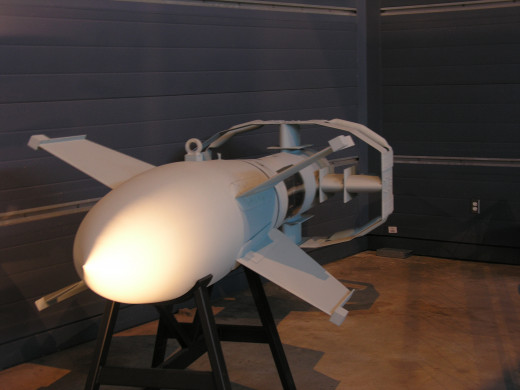- HubPages»
- Education and Science»
- History & Archaeology»
- Military History
The Fritz-X at the Udvar-Hazy Center



The Fritz-X at the Udvar-Hazy Center
The National Air and Space Museum has a Ruhrstahl X-1 on display in the Udvar-Hazy Center in Chantilly, Virginia. It is in the James S. McDonnell Space Hangar. The Smithsonian obtained this radio controlled glide bomb from the U.S. Navy Bureau of Aeronautics.1 Both sides commonly called the Ruhrstahl X-1 the Fritz-X. The Fritz-X had a short but deadly combat history before the Luftwaffe phased it out in favor of the Hs-293. The Fritz-X did all its damage to enemy shipping in one week. The Fritz-X had the advantage over gravity bombs of being steerable. The disadvantages were the radio signal could be jammed and the Fritz-X could be spoofed. The attacking bomber could launch the bomb outside the range of the target ship’s anti-aircraft fire. The bomber had to fly straight and level while the Fritz-X was being guided to its target. This made it more vulnerable to enemy fighters. This seems a good trade-off because if enemy fighters got close enough for the bomber to take evasive action the bomber would be trying to evade a faster and more maneuverable adversary. The Fritz-X was a 3,450 pound bomb that could penetrate 28" of armor.
1National Air & Space Museum web site; (http://airandspace.si.edu/collections/artifact.cfm?object=nasm_A19710760000)
Ships the Fritz-X Struck
Click thumbnail to view full-size



Dornier Do-217
Click thumbnail to view full-size
The Destructive Week of the Fritz-X
- September 8, 1943 - The Allies invaded the Italian Peninsula and Italy switched sides. The next day the Italian Battleships; Roma, Italia, and Vittorio Veneto, along with three cruisers and eight destroyers, left the port of La Spezia. Admiral Carlo Bergamini told the local German commander the flotilla was to attack the Allied naval force at Salerno. The ruse didn’t fool the Germans. The Luftwaffe dispatched 6 Dornier Do-217s, each carrying a Fritz-X, to attack the Italian ships. With the Fritz-X the bombers attacked the ships from outside the range of the ships’ anti-aircraft guns. One Fritz-X narrowly missed the Italia. The Fritz-X explosion jammed the battleship’s rudder. A Fritz-X glide bomb severely damaged the Roma. Then a Do-217, piloted by Oberleutnant Heinrich Schmertz attacked. Feldwebel Oscar Huhn steered the Fritz-X to the Roma.1This second hit caused a fire that reached the magazine and the explosion sank the Roma. Admiral Bergamini and 1,252 other Italian sailors went down with this battleship.2
- September 11 - US Warships were providing artillery support for the army forces at Salerno. Some Do-217s got past the P-38 Lightnings that were providing air cover for the fleet and severely damaged the cruiser USS Savannah. The Fritz-X killed almost 200 of the USS Savannah’s crew members.3 A near miss lightly damaged the cruiser USS Philadelphia and wounded some of her crew.4 The USS Savannah continued to provide artillery support for the landing force. It was sent to the Philadelphia Navy Yard for repairs and modernization. 5 The Royal Netherlands sloop Flores was also damaged from these air attacks.6
- September 12 - The HMS Loyal suffered a near miss from a Fritz-X.7
- September 13 - A Fritz-X severely damaged the HMS Uganda and killed 16 of its sailors. The HMS Uganda underwent repairs in Charleston, South Carolina and was transferred to the Royal Canadian Navy on October 21, 1944.8
- September 16 - The HMS Warspite came under multiple air attacks. One of the Warspite’s 4” anti-aircraft shells hit the destroyer Offa. The shell killed one sailor and wounded several others. A dozen FW-190s unsuccessfully attacked the Warspite. Then some Do-217s of 111/KG 100 attacked the Warspite. The Dorniers released three Fritz-X glide bombs at 20,000 feet. Feldwebel Oscar Huhn scored a direct hit. Stabsfeldwebel Mrowitz and Feldwebel Meyer also guided two Fritz-X glide bombs that were near misses. The attack killed 9 sailors on the Warspite and wounded 14. Tug boats and the Ocean Salvage Vessel Salveda towed the Warspite to Malta for temporary repairs. In November it sailed to Gibraltar for repairs. The ship’s X turret was never repaired.9
1 Guided German air to ground Weapons in World War 2; (http://www.1jma.dk/articles/1jmaluftwaffegroundweapons.htm)
2 Defense Media Network; (http://www.defensemedianetwork.com/stories/the-sinking-of-the-battleship-roma-and-the-dawn-of-the-age-of-precision-guided-munitions/)
3 Australia Airpower Net (http://www.ausairpower.net/WW2-PGMs.html#mozTocId46276)
4 USS Philadelphia CL41 History: (http://www.brigs.us/Phila/CL41-history-we-were-there.htm)
5 Navsource Online: Cruiser Photo Index; (http://www.navsource.org/archives/04/042/04042.htm)
6 Royal Netherlands Warships of World War II; (http://www.netherlandsnavy.nl/Flores_his.htm)
7 Naval History Net (http://www.naval-history.net/xGM-Chrono-10DD-41L-HMS_Loyal.htm)
8 U-Boat Net: (http://www.uboat.net/allies/warships/ship/4034.html)
9 Naval History Net: (http://www.naval-history.net/xGM-Chrono-01BB-Warspite.htm)
This content is accurate and true to the best of the author’s knowledge and is not meant to substitute for formal and individualized advice from a qualified professional.
© 2015 Robert Sacchi

















